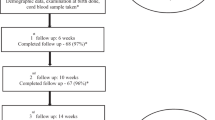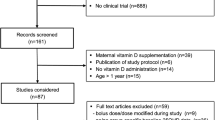Abstract
Introduction
Although the role of vitamin D in the prevention of rickets has long been well established, controversies still exist on the ideal dose of vitamin D supplementation in infants.
Objective
We assessed serum 25-hydroxyvitamin D (25OHD) status simultaneously in maternal and cord samples and the response to vitamin D3 supplementation in neonates.
Methods
Serum 25OHD levels were evaluated from maternal, and umbilical cord samples from term normal pregnancies. Repeat 25OHD levels were assessed in neonates with 25OHD below 30 nmol/L following vitamin D3 200 IU daily after 6 weeks.
Results
Blood samples were taken including 57 cord samples and 16 follow-up neonatal samples. Maternal and cord serum 25OHD were 43 ± 21 and 29 ± 15 nmol/L, respectively. Infants with 25OHD < 30 nmol/L (19.8 ± 4.7 nmol/L) had a significant increase in serum 25OHD (63.3 ± 14.5 nmol/L) following vitamin D3 200 IU daily after 6 weeks.
Conclusion
Healthy Irish infants born at term are at high risk of vitamin D deficiency, but vitamin D3 200 IU daily, rapidly corrects poor vitamin D status.


Similar content being viewed by others
References
Wagner CL, Greer FR (2008) Prevention of rickets and vitamin D deficiency in infants, children, and adolescents. Pediatrics 122:1142–1152. doi:10.1542/peds.2008-1862
Misra M, Pacaud D, Petryk A et al (2008) Vitamin D deficiency in children and its management: review of current knowledge and recommendations. Pediatrics 122:398–417. doi:10.1542/peds.2007-1894
Walker V, Modlin R (2009) The vitamin D connection to pediatric infections and immune function. Pediatr Res 65:106R–113R. doi:10.1203/PDR.0b013e31819dba91
McKenna MJ (1992) Differences in vitamin D status between countries in young adults and the elderly. Am J Med 93:69–77
Holick MF, Chen TC (2008) Vitamin D deficiency: a worldwide problem with health consequences. Am J Clin Nutr 87:1080S–1086S
Ireland H (2010) Vitamin D Supplementation for Infants. http://www.hse.ie/eng/health/child/vitaminD/supplementation.html
Ross AC, Manson JE, Abrams SA et al (2011) The 2011 report on dietary reference intakes for calcium and vitamin D from the Institute of Medicine: what clinicians need to know. J Clin Endocrinol Metab 96:53–58. doi:10.1210/jc.2010-2704
Luxwolda MF, Kuipers RS, Kema IP et al (2012) Traditionally living populations in East Africa have a mean serum 25-hydroxyvitamin D concentration of 115 nmol/l. Br J Nutr 108:1557–1561. doi:10.1017/S0007114511007161
McCarthy RA, McKenna MJ, Oyefeso O et al (2012) Vitamin D nutritional status in preterm infants and response to supplementation. Br J Nutr. doi:10.1017/S0007114512004722
McCarthy RA, McKenna MJ, Oyefeso O et al (2012) Vitamin D nutritional status in preterm infants and response to supplementation. Br J Nutr. doi:10.1017/S0007114512004722
Carter GD (2009) 25-Hydroxyvitamin D assays: the quest for accuracy. Clin Chem 55:1300–1302. doi:10.1373/clinchem.2009.125906
Walsh JM, Kilbane M, McGowan CA et al (2013) Pregnancy in dark winters: implications for fetal bone growth? Fertil Steril 99:206–211. doi:10.1016/j.fertnstert.2012.09.010
Canadian Paediatric Society (2007) Vitamin D supplementation: recommendations for Canadian mothers and infants. Paediatr Child Health 12:583–598
Holick M, Binkley N (2011) Evaluation, treatment, and prevention of vitamin D deficiency: an Endocrine Society clinical practice guideline. Clin Endocrinol 96:1911–1930. doi:10.1210/jc.2011-0385
Agostoni C, Buonocore G, Carnielli VP et al (2010) Enteral nutrient supply for preterm infants: commentary from the European Society of Paediatric Gastroenterology, Hepatology and Nutrition Committee on Nutrition. J Pediatr Gastroenterol Nutr 50:85–91. doi:10.1097/MPG.0b013e3181adaee0
Shakiba M, Sadr S, Nefei Z et al (2010) Combination of bolus dose vitamin D with routine vaccination in infants: a randomised trial. Singapore Med J 51:440–445
Siafarikas A, Piazena H, Feister U et al (2011) Randomised controlled trial analysing supplementation with 250 versus 500 units of vitamin D3, sun exposure and surrounding factors in breastfed infants. Arch Dis Child 96:91–95. doi:10.1136/adc.2009.178301
Author information
Authors and Affiliations
Corresponding author
Ethics declarations
All procedures performed in studies involving human participants were in accordance with the ethical standards of the institutional and/or national research committee and with the 1964 Helsinki declaration and its later amendments or comparable ethical standards.
Conflict of interest
The authors declare no conflict of interest.
Funding
National Maternity Hospital Fund.
Rights and permissions
About this article
Cite this article
Onwuneme, C., Diya, B., Uduma, O. et al. Correction of vitamin D deficiency in a cohort of newborn infants using daily 200 IU vitamin D supplementation. Ir J Med Sci 185, 683–687 (2016). https://doi.org/10.1007/s11845-015-1341-2
Received:
Accepted:
Published:
Issue Date:
DOI: https://doi.org/10.1007/s11845-015-1341-2




